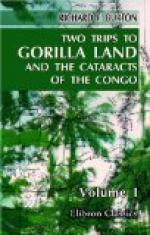An immense mass of nonsense, copied in one “authority” from another, was thrown before the public by books upon diet, until the “Physiology of Common Life” (George Henry Lewes) discussed Liebig’s brilliant error in considering food chemically, and not physiologically. The rest assume his classification without reserve, and work from the axiom that heat-making, carbonaceous and non-nitrogenous foods (e.g. fat and sugars), necessary to support life in the arctic and polar regions, must be exchanged for the tissue-making, plastic or nitrogenous (vegetables), as we approach the equator. They are right as far as the southern temperates, their sole field of observation; they greatly err in all except the hot, dry parts of the tropics. Why, a Hindoo will drink at a sitting a tumbler of gli (clarified butter), and the European who would train for wrestling after the fashion of Hindostan, as I attempted in my youth, on “native” sweetmeats and sugared milk, will be blind with “melancholia” in a week. The diet of the negro is the greasiest possible, witness his “palm-oil chop” and “palaver sauce;” his craving for meat, especially fat meat, is a feeling unknown to Europe. And how simple the reason. Damp heat demands almost as much carbon as damp or dry cold.
Return we to the Baraka Mission. The name is a corruption of “barracoon;” in the palmy days of the trade slave-pens occupied the ground now covered by the chapel, the schoolroom, and the dwelling-house, and extended over the site of the factory to the river-bank. The place is well chosen. Immediately beyond the shore the land swells up to a little rounded hill, clean and grassy like that about Sanga-Tanga. The soil appears poor, and yet around the mission-house there are some fine wild figs, one a huge tree, although not a score of years old; the bamboo clump is magnificent, and the cocoas, oranges, and mangoes are surrounded by thick, fragrant, and luxuriant quickset hedges of well-trimmed lime.
A few words concerning the banana of this coast, which we find so flourishing at Baraka. An immense god-send to the Gaboon, it is well known to be the most productive of all food, 100 square yards of it giving annually nearly 2,000 kilogrammes of food far more nutritious than the potato. Here it is the musa sapientum, the banana de Soa Thome, which has crossed over to the Brazil, and which is there known by its sharper leaves and fruit, softer and shorter than the indigenous growth. The plant everywhere is most vigorous in constant moist heat, the atmosphere of a conservatory, and the ground must be low and wet, but not swampy. The best way of planting the sprouts is so to dispose them that four may form the corners of a square measuring twelve feet each side; the common style is some five feet apart. The raceme, which appears about the sixth to the tenth month, will take sixty days more to ripen; good stocks produce three and more bunches a year, each weighing from twenty to eighty pounds. The stem, after fruiting, should be cut down, in order to let the others enjoy light and air, and the oftener the plants are removed to fresh ground the better.




